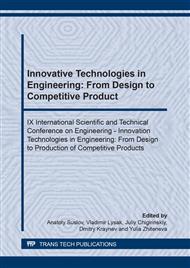[1]
J. Wangqi, Formation of Hot-Top Segregation in Steel Ingot and Effect of Steel Composition, Metallurgical Transactions B. 20B (1989) 723-730.
DOI: 10.1007/bf02655930
Google Scholar
[2]
V.V. Nazaratin, O.A. Kobelev, M.V. Efimov et al., Analysis of technologies used to make hollow ingots and prospects for their improvement. Metallurgist, 56 (2013) 9–10.
DOI: 10.1007/s11015-013-9634-z
Google Scholar
[3]
A. Tomioka, N. Michio, N. Katsushige, Quality of the work roll by new ESR. 16th IFM-2009 75–84.
Google Scholar
[4]
Dub A.V., L.Ya. Levkov, D.A. Shurygin et al.,Production prospectsof equipmentforNPP using ESR,Questions of Atomic Science and Technology,Ser.: Safety of NPPs. 34 (2014) 11–18.
Google Scholar
[5]
S.Ya. Skoblo, E.A. Kazachkov, Ingots for Large Forgings, Metallurgiya, Moscow, (1973).
Google Scholar
[6]
D.V. Rutskii, N.A. Zyuban, Development of defect zones and cast metal structure in elongated two-piece Cr-Ni-Mo steel ingots, CIS Iron and Steel Review. 10 (2015), 14-18.
DOI: 10.17580/cisisr.2015.01.03
Google Scholar
[7]
M.V. Kolodkin, S.I. Zhulyev, V.S. Dub et al., The choice of the rational scheme for casting of a forging ingot for producing hollow forgings, Electrometallurgy. 8 (2009) 26-29.
DOI: 10.1134/s0036029510060169
Google Scholar
[8]
A.S. Eldorhanov, V.А. Yefimov, А.S. Nuratdinov, Forging forming processes and their simulation, Mashinostroyeniye, Moscow, (2001).
Google Scholar
[9]
V.A. Efimov, Casting and crystallization of steel, Metallurgiya, Moscow (1976).
Google Scholar
[10]
H.-I. Shpis, The behavior of nonmetallic inclusions in steel during crystallization and deformation, Metallurgiya, Moscow, (1971).
Google Scholar
[11]
V.A. Shamrey, Investigation of ingots with a cooling feeder head and hollow forging fabrication from them, Dr.Sc. thesis, TSNIICHERMET, Moscow, (2007).
Google Scholar
[12]
V.A. Shamrey, S.I. Zhulyev, New shape of a forging-grade ingot to produce hollow forgings, Metallurgist. 11 (207) 54 – 57.
Google Scholar


